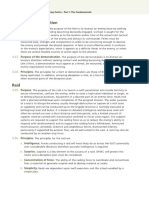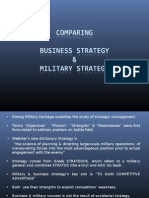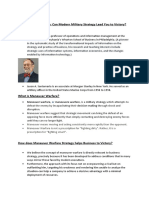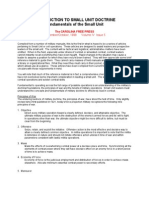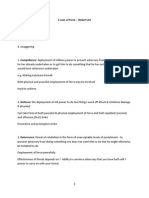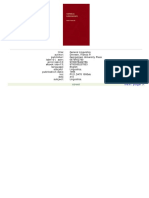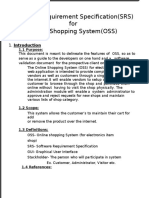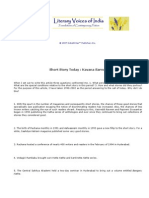Seizing and Holding The Initiative.: Army Field Manual I Warfighting Tactics - Part 1 The Fundamentals - 2-5
Seizing and Holding The Initiative.: Army Field Manual I Warfighting Tactics - Part 1 The Fundamentals - 2-5
Uploaded by
Grozny GroznyCopyright:
Available Formats
Seizing and Holding The Initiative.: Army Field Manual I Warfighting Tactics - Part 1 The Fundamentals - 2-5
Seizing and Holding The Initiative.: Army Field Manual I Warfighting Tactics - Part 1 The Fundamentals - 2-5
Uploaded by
Grozny GroznyOriginal Description:
Original Title
Copyright
Available Formats
Share this document
Did you find this document useful?
Is this content inappropriate?
Report this DocumentCopyright:
Available Formats
Seizing and Holding The Initiative.: Army Field Manual I Warfighting Tactics - Part 1 The Fundamentals - 2-5
Seizing and Holding The Initiative.: Army Field Manual I Warfighting Tactics - Part 1 The Fundamentals - 2-5
Uploaded by
Grozny GroznyCopyright:
Available Formats
Army Field Manual I Warfighting Tactics - Part 1 The Fundamentals | 2-5
2-07. Seizing and holding the initiative. The initiative is the ability to dictate the course
of events, to decide and act before our opponents do and so gain advantage. In
contact with an enemy, gaining, regaining and retaining the initiative requires: tempo,
surprise (and the importance of the use of deception to achieve surprise), pre-emption,
momentum, simultaneity, exploitation and avoiding culmination. They cannot be applied
in isolation, but are mutually reinforcing.25
2-08. Shaping understanding. The manoeuvrist approach seeks to manipulate an enemy’s
understanding to produce behavioural outcomes favourable to the friendly force. The
perception of failure is the best mechanism by which to promote actual failure, convincing
the enemy of the futility of their actions. The shock induced by surprise and an enemy’s
loss of initiative all contribute to this perception of failure. Security, deception and
information activities amplify their effects and are therefore central to the manoeuvrist
approach. They are not, however, sufficient. Shaping the enemy’s understanding
conclusively is rarely achievable without the application or threat of force, attacking will
and cohesion.
2-09. Attacking will and cohesion. The will and cohesion of a force are indivisible. Will is the
determination to persist in the face of adversity. It has two aspects: intent and resolve.
Both can be influenced, attacked and undermined. The enemy’s intent is thwarted
when they believe that their aim is no longer achievable, and so desist from their course
of action. The enemy’s resolve is their strength of will. It is overcome when they are
demoralised and no longer have the desire to continue. It is intimately linked to the
cohesion of the force. The same principle applies to our own force; we must protect our
own will and cohesion from the actions of enemies and adversaries. Will and cohesion
can be attacked through dislocation, disruption and destruction.26
a. Dislocation. Denies the enemy the ability to bring their strengths to bear, or to
persuade them that their strength is irrelevant. Its purpose is wider than the frustration
of the enemy’s plan; it is about ensuring that their strengths are in the wrong place.
b. Disruption. Can be used to break apart and confuse assets that are critical to the
employment and coherence of the enemy’s fighting power. It aims to rupture the
integrity of a force, to render it incapable of deciding and acting purposefully.
c. Destruction. When unsupported or unfocused, is not normally a major contributor to
shock, other than when used on a massive scale. Otherwise, the careful selection and
destruction of discrete capabilities or force elements amplifies the effects of surprise,
dislocation and disruption, and can be decisive in undermining an enemy’s will to fight.
25 ADP Land Operations, Chapter 5, Manoeuvrist Approach, paragraphs 5-08 to 5-14.
26 Ibid paragraphs 5-16 to 5-19.
You might also like
- Warfighting 1Document26 pagesWarfighting 1condorblack2001100% (2)
- Gail Levin-Edward Hopper - The Art and The Artist-W. W. Norton & - Company (1980)Document322 pagesGail Levin-Edward Hopper - The Art and The Artist-W. W. Norton & - Company (1980)Nazif Gür100% (5)
- Manoeuvrist Approach: An Attitude of MindDocument1 pageManoeuvrist Approach: An Attitude of MindGrozny GroznyNo ratings yet
- Chap 2 General Paramilitary TacticsDocument12 pagesChap 2 General Paramilitary TacticsPGNo ratings yet
- Freedom of Action.: 5-4 - Army Field Manual I Warfighting Tactics - Part 1 The FundamentalsDocument1 pageFreedom of Action.: 5-4 - Army Field Manual I Warfighting Tactics - Part 1 The FundamentalsGrozny GroznyNo ratings yet
- Principles. Deception.: Area DefenceDocument1 pagePrinciples. Deception.: Area DefenceGrozny GroznyNo ratings yet
- Feint and Demonstration: Purpose of The FeintDocument1 pageFeint and Demonstration: Purpose of The FeintGrozny GroznyNo ratings yet
- Mobile Defence: PurposeDocument1 pageMobile Defence: PurposeGrozny GroznyNo ratings yet
- Chapter IV Armor Offensive OperationDocument15 pagesChapter IV Armor Offensive OperationmarynicolgeeNo ratings yet
- Principles of War For The Information AgeDocument4 pagesPrinciples of War For The Information AgesensorseekerNo ratings yet
- .Principles of The Art of WarDocument8 pages.Principles of The Art of WarScribdTranslationsNo ratings yet
- Strategic Theories and Concepts: Short Title Concept AuthorDocument7 pagesStrategic Theories and Concepts: Short Title Concept AuthorAgente especial Doofy 9No ratings yet
- VERBS 20220925-UK - Effects - Actions - Verbs 2024-01-11 10 - 09 - 09Document8 pagesVERBS 20220925-UK - Effects - Actions - Verbs 2024-01-11 10 - 09 - 09elie semaanNo ratings yet
- Business Vs Military StrategyDocument5 pagesBusiness Vs Military Strategysmb_146100% (21)
- AttackopsfinalDocument31 pagesAttackopsfinalmarvNo ratings yet
- The Six Principles From Sun Tzu and The Art of Modern WarfareDocument4 pagesThe Six Principles From Sun Tzu and The Art of Modern WarfareSelva Manian100% (2)
- Maneuver Warfare: Can Modern Military Strategy Lead You To Victory?Document2 pagesManeuver Warfare: Can Modern Military Strategy Lead You To Victory?Bhavani venkatesanNo ratings yet
- Military Strategy in A Complex World: February 2016Document23 pagesMilitary Strategy in A Complex World: February 2016MNo ratings yet
- Strategi Es: Life Warfar eDocument36 pagesStrategi Es: Life Warfar eAnonymous kbmKQLe0JNo ratings yet
- Discussion On The Strategy of Exploiting WeaknessesDocument6 pagesDiscussion On The Strategy of Exploiting WeaknessesinfoNo ratings yet
- Chapter 5Document108 pagesChapter 5nguyenvien.vnaNo ratings yet
- Revised FM 05Document7 pagesRevised FM 05jeetdokuneNo ratings yet
- 3 60 Afdp TargetingDocument117 pages3 60 Afdp Targetingrameem rashedNo ratings yet
- StrategyDocument23 pagesStrategyMekhitoNo ratings yet
- Military Deception: Joint Publication 3-13.4Document19 pagesMilitary Deception: Joint Publication 3-13.4nemesis123No ratings yet
- War Strategies For Life Original Data SheetDocument29 pagesWar Strategies For Life Original Data SheetDouglas RadcliffeNo ratings yet
- Shabar Maran VidyaDocument9 pagesShabar Maran VidyaSayan BiswasNo ratings yet
- Introduction To Small Unit Doctrine Fundamentals of The Small UnitDocument4 pagesIntroduction To Small Unit Doctrine Fundamentals of The Small UnitRobert Toner100% (2)
- 17 Fundamentals of Infantry Operations 1Document10 pages17 Fundamentals of Infantry Operations 1Michelle EsternonNo ratings yet
- Lecture - 4 Uses of ForceDocument4 pagesLecture - 4 Uses of ForceHardik ChawlaNo ratings yet
- Sub-Conventional Warfare Requirements, Impact and Way Ahead: FocusDocument15 pagesSub-Conventional Warfare Requirements, Impact and Way Ahead: FocusNikhil Kumar BNo ratings yet
- Sun Tzu's Art of WarDocument31 pagesSun Tzu's Art of WarKit LeeNo ratings yet
- Principles of WarDocument8 pagesPrinciples of WarDirGanz H. GanancialNo ratings yet
- 47 Battle Tactics and Strategies For Your Military RPG CampaignDocument31 pages47 Battle Tactics and Strategies For Your Military RPG CampaignВалерий ЧерновNo ratings yet
- US Marines Close Combat ManualDocument114 pagesUS Marines Close Combat ManualjdgmagicNo ratings yet
- Sword 4 BoydDocument46 pagesSword 4 Boydbovine splendor100% (4)
- Us Mcmap ManualDocument113 pagesUs Mcmap ManualgraalstNo ratings yet
- Disaster Management : Optimising the Global Military ResponseFrom EverandDisaster Management : Optimising the Global Military ResponseNo ratings yet
- Military Incompetence: Unraveling Strategic Failures in WarfareFrom EverandMilitary Incompetence: Unraveling Strategic Failures in WarfareNo ratings yet
- Military Deception: Strategic Illusions, The Art and Science of Warfare DeceitFrom EverandMilitary Deception: Strategic Illusions, The Art and Science of Warfare DeceitNo ratings yet
- The Operational Implications Of Deception At The Battle Of KurskFrom EverandThe Operational Implications Of Deception At The Battle Of KurskNo ratings yet
- Art of War Summary: Read Every Morning - Win All Life’s Competitions - Sun Tzu’s Whole Book in 15 MinutesFrom EverandArt of War Summary: Read Every Morning - Win All Life’s Competitions - Sun Tzu’s Whole Book in 15 MinutesRating: 4.5 out of 5 stars4.5/5 (3)
- Defensive Culmination - When Does The Tactical Commander Counterattack?From EverandDefensive Culmination - When Does The Tactical Commander Counterattack?Rating: 5 out of 5 stars5/5 (1)
- Navigating the Unknown: A Guide to Thriving in Uncharted TerritoriesFrom EverandNavigating the Unknown: A Guide to Thriving in Uncharted TerritoriesNo ratings yet
- Art of War on the Battlefield Guide to Modern Military OperationsFrom EverandArt of War on the Battlefield Guide to Modern Military OperationsNo ratings yet
- Combat Techniques: The Complete Guide to How Soldiers Fight Wars TodayFrom EverandCombat Techniques: The Complete Guide to How Soldiers Fight Wars TodayRating: 4.5 out of 5 stars4.5/5 (5)
- The Manipulation Survival Guide: Effective Strategies to Navigate and Thrive in a World of DeceptionFrom EverandThe Manipulation Survival Guide: Effective Strategies to Navigate and Thrive in a World of DeceptionNo ratings yet
- Leadership Resilience: Emotional Intelligence in Challenging Times.From EverandLeadership Resilience: Emotional Intelligence in Challenging Times.No ratings yet
- Anti-Access Warfare: Countering A2/AD StrategiesFrom EverandAnti-Access Warfare: Countering A2/AD StrategiesRating: 4 out of 5 stars4/5 (1)
- When the Cat met the Dog: How to get Along with Almost Anyone at WorkFrom EverandWhen the Cat met the Dog: How to get Along with Almost Anyone at WorkNo ratings yet
- The Power Playbook: Mastering The Art Of Influence Navigating The Complex World Of Power DynamicsFrom EverandThe Power Playbook: Mastering The Art Of Influence Navigating The Complex World Of Power DynamicsNo ratings yet
- Francesco de AccoltiDocument1 pageFrancesco de AccoltiGrozny GroznyNo ratings yet
- Potato Dextrose Agar: Typical CompositionDocument2 pagesPotato Dextrose Agar: Typical CompositionGrozny GroznyNo ratings yet
- Alternaria Leaf SpotDocument3 pagesAlternaria Leaf SpotGrozny GroznyNo ratings yet
- 2-Acetyl-1-Pyrroline: Structure and PropertiesDocument2 pages2-Acetyl-1-Pyrroline: Structure and PropertiesGrozny GroznyNo ratings yet
- 6-Acetyl-2,3,4,5-Tetrahydropyridine: Structure and PropertiesDocument3 pages6-Acetyl-2,3,4,5-Tetrahydropyridine: Structure and PropertiesGrozny GroznyNo ratings yet
- Breakout of Encircled Forces: PurposeDocument1 pageBreakout of Encircled Forces: PurposeGrozny GroznyNo ratings yet
- Combined, Joint, Inter-Agency, Intra-Governmental or Multinational (CJIIM)Document1 pageCombined, Joint, Inter-Agency, Intra-Governmental or Multinational (CJIIM)Grozny GroznyNo ratings yet
- Mobile Defence: PurposeDocument1 pageMobile Defence: PurposeGrozny GroznyNo ratings yet
- 3-4 - Army Field Manual I Warfighting Tactics - Part 1 The FundamentalsDocument1 page3-4 - Army Field Manual I Warfighting Tactics - Part 1 The FundamentalsGrozny GroznyNo ratings yet
- Physical, Virtual and Cognitive Dimensions: Deep OperationsDocument1 pagePhysical, Virtual and Cognitive Dimensions: Deep OperationsGrozny GroznyNo ratings yet
- 3-6 - Army Field Manual I Warfighting Tactics - Part 1 The FundamentalsDocument1 page3-6 - Army Field Manual I Warfighting Tactics - Part 1 The FundamentalsGrozny GroznyNo ratings yet
- Encirclement.: Army Field Manual I Warfighting Tactics - Part 1 The Fundamentals - 4-7Document1 pageEncirclement.: Army Field Manual I Warfighting Tactics - Part 1 The Fundamentals - 4-7Grozny GroznyNo ratings yet
- Understanding.: 2-2 - Army Field Manual I Warfighting Tactics - Part 1 The FundamentalsDocument1 pageUnderstanding.: 2-2 - Army Field Manual I Warfighting Tactics - Part 1 The FundamentalsGrozny GroznyNo ratings yet
- ض1 PDFDocument1 pageض1 PDFGrozny GroznyNo ratings yet
- Relief of Troops: Purpose. Relief in Place. Forward Passage of LinesDocument1 pageRelief of Troops: Purpose. Relief in Place. Forward Passage of LinesGrozny GroznyNo ratings yet
- Mission Command: 2-6 - Army Field Manual I Warfighting Tactics - Part 1 The FundamentalsDocument1 pageMission Command: 2-6 - Army Field Manual I Warfighting Tactics - Part 1 The FundamentalsGrozny GroznyNo ratings yet
- Meeting The Challenge.: 1-4 - Army Field Manual I Warfighting Tactics - Part 1 The FundamentalsDocument1 pageMeeting The Challenge.: 1-4 - Army Field Manual I Warfighting Tactics - Part 1 The FundamentalsGrozny GroznyNo ratings yet
- Forward Passage of Lines: Principles. Maintain The Mission. Security. SimplicityDocument1 pageForward Passage of Lines: Principles. Maintain The Mission. Security. SimplicityGrozny GroznyNo ratings yet
- Forest Lawn Memorial Park Is A Privately Owned Cemetery inDocument5 pagesForest Lawn Memorial Park Is A Privately Owned Cemetery inGrozny GroznyNo ratings yet
- 1-2 - Army Field Manual I Warfighting Tactics - Part 1 The FundamentalsDocument1 page1-2 - Army Field Manual I Warfighting Tactics - Part 1 The FundamentalsGrozny GroznyNo ratings yet
- Handling Instructions & Conditions of ReleaseDocument1 pageHandling Instructions & Conditions of ReleaseGrozny GroznyNo ratings yet
- Erich Von StroheimDocument13 pagesErich Von StroheimGrozny GroznyNo ratings yet
- Preface: Brigade Tactics (2012) and Part 2 Battlegroup Tactics (2014)Document1 pagePreface: Brigade Tactics (2012) and Part 2 Battlegroup Tactics (2014)Grozny GroznyNo ratings yet
- Lesson Plan 4 - Titch StoryDocument9 pagesLesson Plan 4 - Titch Storyapi-295499489No ratings yet
- DinnenDocument734 pagesDinnenSebastián Caro Landeros100% (1)
- Model Paper - Compensation ManagementDocument2 pagesModel Paper - Compensation ManagementChandrabhan OjhaNo ratings yet
- Guanzon v. de VillaDocument2 pagesGuanzon v. de VillaAngela AquinoNo ratings yet
- KKKKDocument7 pagesKKKKNkurunziza PascalNo ratings yet
- Guide To The PhilDocument3 pagesGuide To The PhilMamam blueNo ratings yet
- General Worker Resume TemplateDocument3 pagesGeneral Worker Resume TemplateFlexi ServicesNo ratings yet
- Occupational Health and SafetyDocument7 pagesOccupational Health and SafetyZyvirl BanoyoNo ratings yet
- In Re - Judge ManzanoDocument2 pagesIn Re - Judge ManzanoRmLyn Mclnao100% (1)
- Case Study BrazileDocument9 pagesCase Study BrazileAdeelNo ratings yet
- People of The Philippinnes Vs BienvinidoDocument4 pagesPeople of The Philippinnes Vs BienvinidoAli50% (2)
- SRS ...... E-Commerce Web ApplicationDocument13 pagesSRS ...... E-Commerce Web Applicationshubham100% (1)
- Caste Discrimination: "Caste Is Not Just A Division of Labour, It Is A Division of Labourers" - B.R. AmbedkarDocument3 pagesCaste Discrimination: "Caste Is Not Just A Division of Labour, It Is A Division of Labourers" - B.R. AmbedkarShouryam DuttaNo ratings yet
- Graduate Aptitude Test in Engineering: Cleanup GuidelineDocument3 pagesGraduate Aptitude Test in Engineering: Cleanup Guidelinearon stromNo ratings yet
- Jardin Botanico de CuliacanDocument12 pagesJardin Botanico de CuliacancamiloNo ratings yet
- Gis CurrDocument149 pagesGis CurrKatibu KataNo ratings yet
- 1 8 Stages of Genocide NotesDocument2 pages1 8 Stages of Genocide NotesBelle HamiltonNo ratings yet
- Kavana SarmaDocument10 pagesKavana SarmajohnieursNo ratings yet
- Oral Com 2nd Quarterly TestDocument5 pagesOral Com 2nd Quarterly Testjanice daef100% (2)
- TLE Department Action Plan 2016 2017Document8 pagesTLE Department Action Plan 2016 2017Kim Josashiwa BergulaNo ratings yet
- ISO 27001 Certification Process Overview PDFDocument7 pagesISO 27001 Certification Process Overview PDFIokepa TaysenNo ratings yet
- An Investigation On Approaches Used To Teach Literature in The ESL ClassroomDocument7 pagesAn Investigation On Approaches Used To Teach Literature in The ESL ClassroomOthman Najib100% (1)
- PanganDocument1 pagePanganddddNo ratings yet
- NewsroomDocument8 pagesNewsroomMantashaNo ratings yet
- Chapter 8 PromotionDocument38 pagesChapter 8 PromotionNguyễn VyNo ratings yet
- Hearts & Minds - How To Win Hearts & Minds - POSTER (Excellent Pres of HSE Ladder, Beh Change)Document1 pageHearts & Minds - How To Win Hearts & Minds - POSTER (Excellent Pres of HSE Ladder, Beh Change)Cezar Dumitriu100% (1)
- The New Zealand Legal SystemDocument39 pagesThe New Zealand Legal Systemngatihura100% (1)
- Application Form: Presidential Management StaffDocument3 pagesApplication Form: Presidential Management StaffJake CastañedaNo ratings yet
- MCEA PresentationDocument21 pagesMCEA Presentationachopra14No ratings yet






